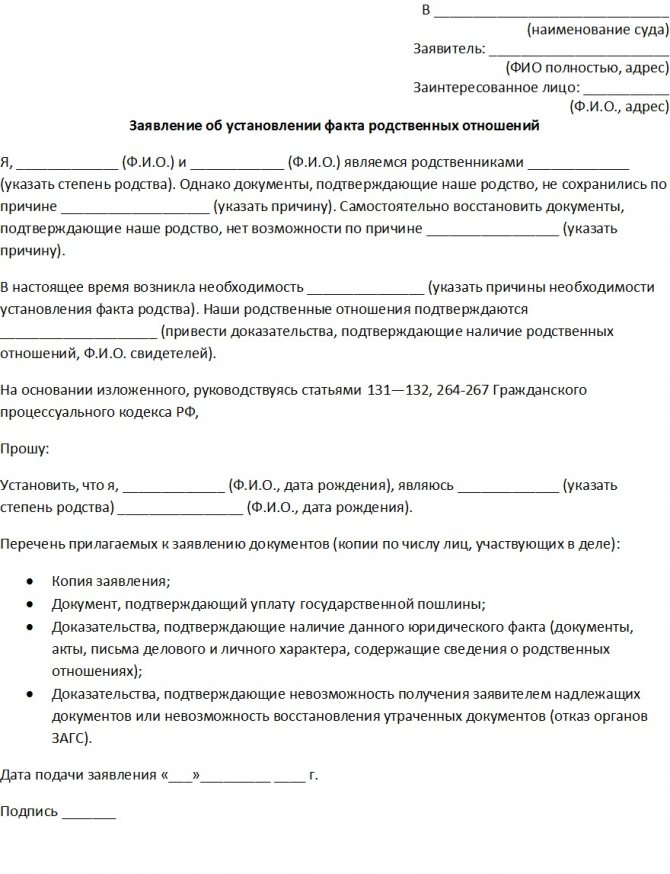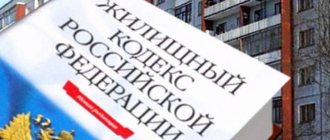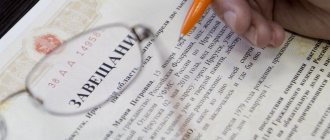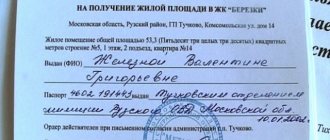Home / Inheritance / How to prove and establish relationship with the deceased
Family relations are regulated not only by moral, but also by legal norms, and imply the presence of rights and responsibilities. To exercise some rights, usually those that entail legal consequences, confirmation of family ties is required.
This article is devoted to the issue of establishing family ties - with the help of documents or judicial procedure.
In what situations is proof of relationship needed?
The most common life situations in which proof of relationship may be required are the following:
- opening an inheritance case;
- confirmation of nationality upon immigration;
- collection of alimony from parents, children, husband/wife.
In some cases, citizens can do without the judicial procedure. For example, the procedure for paying alimony can be discussed in a voluntary written agreement; a family relationship with the testator can be proven by restoring documents in the registry office.
In cases where all possible non-judicial methods of resolving a problematic issue have been exhausted, the issue has to be resolved in court.
How to confirm the fact of kinship when entering into an inheritance?
According to Art. 1111 of the Civil Code of the Russian Federation, inheritance can occur by law or by will.
If inheritance occurs according to law, the heir only needs to present to the notary a will in which he is indicated as the recipient of the inherited property, and identification documents. The notary will issue a Certificate of Inheritance to such an heir, and although it will not indicate the degree of family relationship, this will not in any way affect the availability of property rights. If the deceased did not leave a testamentary disposition and the inheritance occurs according to law, the heir must provide the notary with documents confirming that there was a family connection between him and the deceased testator.
Documents confirming relationship with the deceased
The notary who handles the inheritance case includes the citizen among the legal heirs only if he presents indisputable documentary evidence of kinship with the testator.
As a rule, the main documents are:
- Birth certificate of the heir;
- Certificate of birth, adoption, marriage/divorce, change of name or surname (mother, father, grandfather, grandmother, brother, sister and other relatives) - to restore the chain of kinship ties;
- Death certificate of the testator (other relatives);
For example: an applicant for an inheritance who is the grandson of the testator must present his own birth certificate, as well as the birth and death certificate of the father or mother - the primary applicants for the inheritance.
The number of documents that may be required to prove relationship directly depends on the degree of relationship. The closer the family connection, the fewer documents are needed. And vice versa.
Additional documents may include: a passport with a record of marriage or divorce, the birth of children, a certificate of family composition issued by the housing authority based on an entry in the house register; a certificate confirming that you are dependent on the testator.
Establishing kinship and the fact of kinship relationships. How to prove or confirm relationship.
Kirovsky District Court of St. Petersburg St. Petersburg, st. Marshala Govorova, 38
Applicant: Nikitina Natalia Vladimirovna, Address: 192236 St. Petersburg, st. Lenina, 23, building 1, apt. 6 t.2626262
Interested person: Administration of the Kirov district, Address: 197374, St. Petersburg, Stachek Ave., 18
STATEMENT FOR ESTABLISHING RELATIONSHIP (special proceedings)
On December 30, 2010, Svetlana Ivanovna Elizarova (born July 10, 1924) died. At the time of the death of S.I. Elizarov lived at the address: St. Petersburg, Voznesensky pr. 58, building 2, apt. 25.
After her death, an inheritance was opened consisting of ? share of the apartment located at the address: St. Petersburg, Voznesensky pr., 53, building 2, apt. 255. (A copy of the certificate of ownership of Svetlana Ivanovna Elizarova for ? part of the apartment is attached).
The legal heir is me, Nikitina Natalia Vladimirovna, there are no other heirs. The testator, Elizarova (Ivanova) Svetlana Ivanovna, is my aunt, since my mother, Okuneva (Ivanova) Valentina Ivanovna, was her sister.
I submitted an application for acceptance of the inheritance to the notary of the notarial district of St. Petersburg, Elena Evgenievna Eremenko. Notary Eremenko E.E. On May 11, 2011, a decision was made to refuse to perform a notarial act, since I was unable to document my relationship with my aunt, Elizarova (Ivanova) Svetlana Ivanovna. (Resolution on refusal to perform a notarial act dated May 11, 2011 is attached).
When I submitted a request to the Central State Archives of St. Petersburg, I was informed that in the incomplete documents of the archival fund of the collection “Civil Status Acts of Leningrad and the Leningrad Province” there is no information about the registration of the birth of Ivanova (Elizarova) Svetlana Ivanovna. (The response to the request of the Central State Archives of St. Petersburg is attached).
In this regard, I had a need to go to court to establish my relationship with my aunt, Elizarova (Ivanova) Svetlana Ivanovna, since I have no other opportunity to restore the birth certificate of Ivanova (Elizarova) Svetlana Ivanovna.
The following evidence confirms my relationship with my aunt:
My mother, Okuneva Valentina Ivanovna (Ivanova V.I.) and my aunt, Elizarova (Ivanova) Svetlana Ivanovna, are sisters, and bore the surname “Ivanova” before marriage. This is confirmed by the following documents: birth certificate of Ivanova (in marriage Okuneva) Valentina Ivanovna; marriage certificate of Vladimir Ivanovich Lugovsky and Svetlana Ivanovna Ivanova (Lugovskaya) (change of surname to “Lugovskaya”); death certificate of Vladimir Ivanovich Lugovsky; marriage certificate of Alexey Antonovich Elizarov and Svetlana Ivanovna Lugovskaya (Ivanova) (change of surname to “Elizarova”).
My mother, Okuneva Valentina Ivanovna (Ivanova V.I.) and my aunt, Elizarova (Ivanova) Svetlana Ivanovna, have the same patronymic - “Ivanovna”. This is confirmed by the following documents: birth certificate of Ivanova (Okuneva) Valentina Ivanovna; marriage certificate of Vladimir Ivanovich Lugovsky and Svetlana Ivanovna Ivanova.
My mother, Okuneva (Ivanova) Valentina Ivanovna, and aunt, Elizarova (Ivanova) Svetlana Ivanovna, were born in the same place - the village of Yutsy, Pskov district, Leningrad region. This is confirmed by the military ID of Elizarova (Ivanova) Svetlana Ivanovna and the birth certificate of Ivanova (Okuneva) Valentina Ivanovna.
Also, my relationship with my aunt can be confirmed by the testimony of a close person of the deceased Elizarova (Ivanova) Zinaida Ivanovna - Tatyana Leonidovna Kravchenko.
Based on the above and in accordance with Art. Art. 264-268 Code of Civil Procedure of the Russian Federation, I ASK:
1.
To establish that I, Nikitina Natalia Vladimirovna (born October 25, 1947), am the niece of Svetlana Ivanovna Elizarova (Ivanova) (07/10/1924) on my mother’s side.
2.
Summon to court witness Tatyana Leonidovna Kravchenko, living at the address: St. Petersburg, Irinovsky Ave., 53, building 2, apt. 25.
APPLICATION:
1.
A copy of the certificate of ownership of Elizarova (Ivanova) Zinaida Ivanovna for ? share in an apartment located at the address: St. Petersburg, Voznesensky pr., 58, building 2, apt. 25– 2 copies.
2.
A copy of the birth certificate of Natalia Vladimirovna Nikitina. – 2 copies.
3.
A copy of the marriage certificate of Boris Nikolaevich Nikitin and Natalia Vladimirovna Nikitina. – 2 copies.
4.
A copy of the resolution refusing to perform a notarial act. – 2 copies.
5.
A copy of the response to the request of the St. Petersburg State University “Central State Archives of St. Petersburg.” – 2 copies.
6.
A copy of the birth certificate of Valentina Ivanovna Ivanova (Okuneva). – 2 copies.
7.
A copy of the marriage certificate of Vladimir Ivanovich Lugovsky and Svetlana Ivanovna Ivanova (Elizarova). – 2 copies.
8.
A copy of the death certificate of Vladimir Ivanovich Lugovsky. – 2 copies.
9.
A copy of the marriage certificate of Alexey Antonovich Elizarov and Svetlana Ivanovna Lugovskaya (Ivanova). – 2 copies.
10.
A copy of the military ID of Svetlana Ivanovna Elizarova (Ivanova). – 2 copies.
11.
A copy of the death certificate of Alexey Antonovich Elizarov. – 2 copies.
12.
A copy of the death certificate of Valentina Ivanovna Elizarova. – 2 copies.
13.
A copy of the certificate for participation in the heroic defense of Leningrad in the name of S.I. Ivanova. – 2 copies.
14.
A copy of the certificate for the medal on S.I. Ivanova. – 2 copies.
15.
A copy of the death certificate of Valentina Ivanovna Okuneva. – 2 copies.
16.
Receipt for payment of state duty in the amount of 200 rubles.
17.
A copy of the application.
The originals of all documents will be presented at the court hearing.
September 1, 2011 Applicant (signature) Nikitina N.V.
Bernitsyna Anna for Heir-SPB
What to do if there are no documents?
It often happens that documents necessary to confirm a relationship are damaged or lost. The law provides for a procedure for restoring documentation through the registry office.
What should be done?
- Systematize the available information about a relative: when he was born and died, in which cities he lived, when, where, with whom he registered or divorced, gave birth to children, acquired valuable property, etc.
- Send requests (using mail or the Internet service of the Unified Portal) for the issuance of duplicates of the necessary documents to the civil registry office at the place of residence (city or district) of the relative. If the necessary information is found, a certificate or a duplicate certificate will be issued to the applicant at the civil registry office at the place of residence; if not, the civil registry office will provide the applicant with a justified written refusal.
- Make a request to the archives where old documents are transferred and stored.
- Submit the received documents to the notary's office.
Documents confirming family relationships
There are several acts and certificates to confirm the existence of a family relationship. Among them:
- certificates, including marriage, birth of a child and others;
- certificates from archives or the registry office, if data on the required persons could be saved. They are evidence that can be provided to a notary office;
- court order. In the absence of basic acts or the need to resolve legal disputes, they turn to the court, which makes a decision and issues documentation, with which you can then contact a notary.
Each option has its own characteristics and processes for obtaining them if necessary.
Certificate
According to the law, any civil act is registered and issued in the form of a certificate. This could be the birth of a child, a marriage or its dissolution, as well as the death of a person or a change of data (full name). This documentation is kept in the hands of the person, but if lost or damaged, they can be obtained from the same authority where they were issued.
Attention! If they do not want to provide a duplicate, then this can be achieved with the help of the court.
The number of certificates that certify the presence of blood affinity varies depending on the distance of relatives to each other. Example, to formalize a line of descent with a grandmother, a grandson will need the following documentation:
- birth data of the father or mother, depending on who is the grandmother’s child;
- own birth data;
- information on parents' marriage.
Read also: Registration of ownership rights to real estate
It turns out that several certificates will be required that will fully confirm the family line.
Identification
An identity document is most often expressed as a birth certificate or a Russian passport.
Citizens have notes in their passports about marriages, their dissolution, as well as about children and parents. This information is used to establish family relationships.
Genetic testing result
The DNA test has a high accuracy of determination, which allows it to be used in controversial issues and various court decisions.
The procedure has a fee and must be carried out strictly in organizations with a license for these services. Genetic testing requires the following steps:
- provision of genetic material for research from two individuals for whom it is necessary to establish the degree of relationship;
- concluding a contract for the provision of services;
- receive official results in document form.
On a note! If necessary, such a procedure is authorized through the judicial system.
Since the examination establishes the degree of proximity, it is possible to involve another person who is a relative of the deceased or absent person.
During legal proceedings, based on the data received, the court officially establishes the existence of proximity between the participants in the process and other persons.
Judicial procedure for recognizing kinship
Unfortunately, a characteristic feature of such “family stories” is complexity and confusion, especially after many years, so it is often necessary to understand the intricacies of family relationships with the participation of the judiciary.
So, if the heir has received a written refusal from the registry office, he will have to go to court to establish family ties. Article 264 of the Code of Civil Procedure of the Russian Federation contains a list of cases on the establishment of legal facts that are considered in special proceedings, among them - cases on confirmation of the fact of kinship.
Unlike a notary or other government bodies, the court can make a decision not only on the basis of indisputable evidence. He can fill the gap in the chain of reliable evidence with evidence that is indirectly related to the case - witness statements, photographs, letters, etc.
Note! You can submit an application to the court to confirm your relationship only after all other ways to resolve this issue have been exhausted: searching for lost documents, submitting requests to the registry office and archives.
If there is a dispute between citizens, the case must be considered in a lawsuit.
Statute of limitations
Cases concerning the establishment of family ties between citizens are not limited by the statute of limitations, just like the family connection itself.
But there are statutes of limitations for cases that require proof of relationship. If the deadline is missed without a good reason, it is no longer possible to exercise the rights. For example, the period for accepting an inheritance is 6 months, for collecting alimony for a child - until the child reaches adulthood.
How to establish the fact of relationship through court?
The procedure for confirming kinship in court is as follows:
- filing an application to the court to establish a family relationship;
- attachment to the application of a pre-prepared package of documents confirming the relationship;
- payment of the state fee for filing an application;
- waiting for the results of the application review;
- receiving a court decision by mail or in person.
Cases considered in special proceedings do not provide for open court hearings with the parties summoned. After the decision is made, the case is closed, but the parties retain the right to challenge the court's decision.
Parties to the lawsuit
The judicial procedure in special proceedings involves the parties:
- Applicant - a person who needs recognition of the fact of a family relationship and asks the court to establish this fact based on the evidence presented;
- An interested person - an organization, for example, a notary, who does not have reliable evidence of the fact of relationship between citizens.
How to make an application?
There are no special requirements for an application for recognition of a legal fact - it must comply with the general requirements provided for by civil procedure legislation.
The application must contain the following information:
- Name, address of the judicial authority (city or district court at the applicant’s place of residence) to which the application is submitted;
- Information about the applicant (full name, address);
- Information about the interested party;
- Title of the document: “Statement to confirm the fact of relationship...”
- Statement of the circumstances of the case: fact of family relations, loss or damage of supporting documents, inability to restore documents, other evidence of relationship;
- Link to the relevant legislative norms (Articles 131-132, 264-267 of the Code of Civil Procedure of the Russian Federation);
- Request to the court: confirm the fact of family relations;
- List of documents;
- Date of;
- Signature.

Documentation
The application must be accompanied by all documents and other evidence that are available and relevant to the case:
- Certificates, extracts issued by civil registry offices;
- Archival references;
- Decisions, court orders;
- Certificates, extracts from house books issued by housing authorities;
- Certificates issued at the place of work;
- Certificates issued by social security authorities.
Other evidence, in addition to documentary evidence, may include testimony from friends, employees and co-workers, neighbors, as well as photographs, personal correspondence, video and audio recordings illustrating the life of relatives. Often, an expert report on a DNA test or exhumation of a body is also considered as evidence in court proceedings.
As mentioned above, unlike a notary, the court can make a decision not only on the basis of reliable evidence, but also on the basis of additional, indirect evidence. Any information relevant to the case will be useful - the more evidence the applicant provides, the higher his chances of proving the relationship.
Arbitrage practice
The court's decision depends on how accurate, complete and convincing the documentary and other evidence presented by the applicant was.
Judicial practice shows that most cases are resolved in favor of the applicant if the purpose of going to court is well-reasoned and if the evidence presented is sufficient to confirm the required legal fact.
A court decision may contain not only recognition of family ties, but also the legal consequences, rights and obligations of citizens arising from it, for example, on the payment of alimony, on the right to inheritance.
The court decision is made without summoning the parties to the court hearing and is communicated by mail.
It comes into force immediately after issuance and becomes generally binding on the parties. But if a party does not agree with the court’s decision, it has the right to challenge it. Attention!
- Due to frequent changes in legislation, information sometimes becomes outdated faster than we can update it on the website.
- All cases are very individual and depend on many factors. Basic information does not guarantee a solution to your specific problems.
That's why FREE expert consultants work for you around the clock!
- via the form (below), or via online chat
- Call the hotline:
- Moscow and the Region
- St. Petersburg and region
- FREE for a lawyer!

By submitting data you agree to the Consent to PD Processing, PD Processing Policy and User Agreement.
Anonymously
Information about you will not be disclosed
Fast
Fill out the form and a lawyer will contact you within 5 minutes
Tell your friends
Rate ( 1 ratings, average: 5.00 out of 5)
Author of the article
Irina Garmash
Family law consultant.
Author's rating
Articles written
612
What documents confirm relationship?
Kinship is a relationship between citizens that is based on descent from a common ancestor. Often, everyone knows their close and distant relatives. However, it also happens that for some reason or due to the prevailing circumstances, you may not be aware of the existence of blood relatives.
Based on kinship, a citizen can claim rights to property, apply for alimony, establish the right to bury a loved one, etc. To do this, you should understand what documents are needed to confirm kinship and how to establish kinship with the deceased.
List of documents to confirm family ties
First, let's look at documents confirming family relationships with the deceased. And let’s decide who issues certificates of family relationships.
- Certificates issued upon request by the Civil Registry Office and the MFC. These are certificates of marriage, or its dissolution, death or birth. Certificate confirming the change of last name/first name. This also includes all other entries made on the basis of these certificates in the passport, house register, etc.
- Court decisions - adoption, adoption, or any other recognition of the relationship between relatives.
There are also a number of additional documents. They do not have official status, and therefore only partially confirm the relationship.
- extracts from archives containing information about relationships between two or more persons;
- entries in school registers and any other educational institutions;
- agreements of gift and transfer of property;
- photographs from family albums;
- letters, or other personal correspondence, etc.
Important! The testimony of mutual relatives, friends, acquaintances, colleagues, etc., as witnesses, can also, in turn, act as indirect evidence confirming your family ties with one or another family member. Documents confirming relationship with mother or father:
Documents confirming relationship with mother or father:
- DNA test result;
- Certificate confirming the birth of the child;
- Any certificate of change of name, for example, a marriage certificate, as a result of which the child changed his last name;
- Extract from the Civil Registry Office;
- Court statement.
In addition, the following will help prove the relationship between parent and child:
- A note about children in the parent’s passport;
- Certificate of adoption. For example, if the child was taken from an orphanage;
- If citizens live together, then a certificate from the place of residence or an extract from the house register.
How can I confirm my relationship with my sister or brother? The main documents for confirmation will be birth certificates (of both), marriage certificate and, as a result, a possible change of surname.
List of documents confirming relationship.
How to prove relationship with the deceased in order to receive an inheritance? To do this, you will need documents confirming your relationship.
- certificates of relevant content issued by the competent authorities upon request. For example, certificates from the registry office;
- entries made in passports;
- extracts from archives with relevant content;
- certificates and other documents.
They will definitely come in handy when a person enters into an inheritance. How to prove the degree of relationship during inheritance? Naturally, submit the relevant documents. These include:
- birth certificate (of the heir himself);
- certificate confirming the death of the testator;
- other evidence on which your connection with the deceased testator may directly depend.
Where can I get these documents?
All civil status records are stored in the Civil Registry Office at the place of permanent registration of the citizen.
In order to receive a copy of a document in case of damage or loss, you must write a corresponding application. The following have the right to receive a duplicate:
- directly the citizen himself;
- relatives of the deceased;
- official guardians of incapacitated persons.
Where such documents may be needed
- death of a relative;
- inheritance of property;
- registration of a social pension or in the event of the loss of a breadwinner;
- registration of a deceased person's pension;
- registration of any housing benefits for disabled children.
Conclusion
Documents confirming relationship are one of the main participants in housing issues. The loss of documents entails troublesome recovery. It is better to store them out of the reach of children to prevent damage and loss.









